Fortress, garden, sonnet, womb: Rereading the eight of swords
On working gracefully and skillfully with constraint (or trying to)
"The unconscious is like a compass, it doesn't tell you what to do. Unless you can read the compass it cannot help you. "
-Carl Jung, Visions Seminar
One of my favorite punchlines of the cosmic joke of my situation is that my bedroom literally has yellow wallpaper. The Yellow Wallpaper, a short story by Charlotte Perkins Gilman, is about a bedbound woman who goes mad staring at the fading wallpaper of the room in which she is confined by her husband, a Victorian physician and agent of villainous patriarchy.
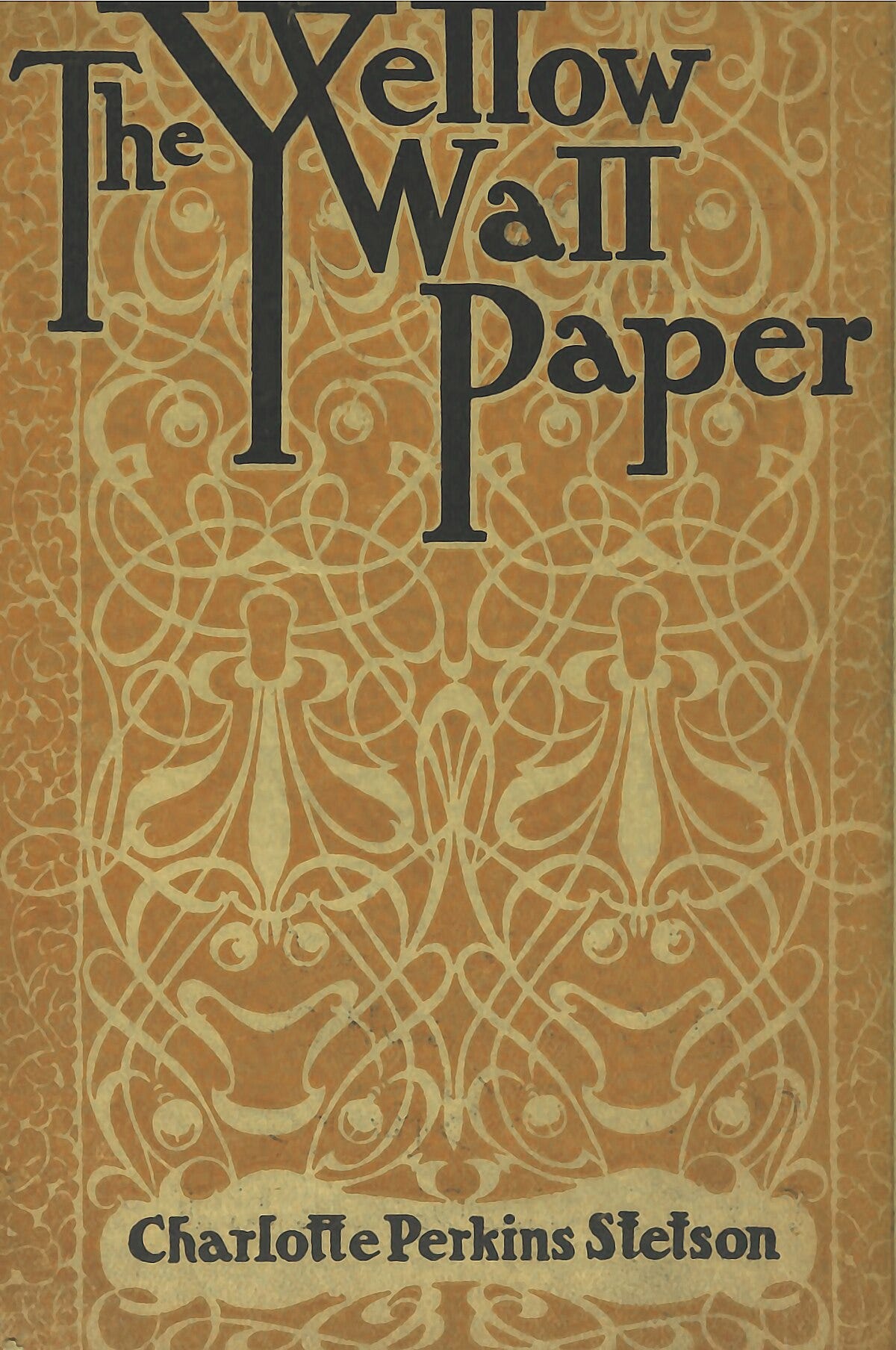
It’s late spring, now. I’m stuck in bed, as I have been since my surgery last July. Outside the birds are making a glorious racket, caught up, presumably, in the process of making more birds. They aren’t so different from humans, with their plumage and courtship rituals. I imagine the tree outside as a dance club, the late afternoon sun an orange disco ball. Twitchy sparrows, red-breasted robins, aggro blue jays, chirping over each other, chasing and being chased, posturing, preening—peacocking, so to speak. Their collective song like voices speaking over each other, blurring into the roar of a crowd.
The stories we tell ourselves about our situation create the context in which we understand ourselves. Like an arrow through the present moment, implying past and future. Pointing us toward what is logical to think and feel.
The Yellow Wallpaper is not a helpful story to invoke.
The eight of swords
A figure bound, blindfolded with loose strips of cloth. Around her, a circle of swords, their blades driven unevenly into the earth. The figure’s expression is mostly hidden by the blindfold, and difficult to read; her mouth a crooked slash, she could be serene or resigned, amused or checked out. She doesn’t look half as distressed as I’d be.
It’s a hell of a card to pull when you’re stuck in bed, stewing in your own grime because your nervous system can’t tolerate being upright for long enough for a shower, sick to death of being sick, with no idea what to do next.
Tarot cards connect us with the Jungian compass. If you let yourself think deeply enough about them, they always, always carry the seed of their own resolution. If you stare into them long enough, the imagery begins to shift, to offer new possibilities. Like repeating a mantra until its sounds are decoupled from their meaning. It becomes a portal to something else.
So I’ve been gazing into the eight of swords, trying to restory my stuckness.
Some rereadings
There is a fine line between imprisonment and sanctuary. A circle of swords, like a fence, can confine or protect. In the same way, a flare of symptoms can serve as a deterrent or a warning, marking a clear perimeter between what my body can and can’t tolerate.
Constraint is also an invitation to creative thinking and problem solving, perhaps even a precondition for creativity. The sonnet offers formal constraints for the poet to riff within and against. It is in the dance with constraint, in that friction, that genius emerges. Constraint can be a lens through which new possibility becomes visible, or the impetus to look for new possibilities. It is a list of demands or questions that invites novel responses.
Finally, constraint is an invitation to self-transformation. If you can’t transform your situation, and you can’t work with it, then the only option left is that you, yourself, have to change. There is nowhere left to go; you have to become someone capable of staying. There is no way to stop the pain; you have to become someone capable of enduring. There’s no way to make some vitally important thing work; you have to become someone capable of leaving the broken thing behind. In this way, the eight of swords begins to feel like a cauldron, where one substance is alchemized into another, or perhaps a garden or a womb, a place where new forms gestate and grow.
Creativity and constraint
How can I dance with the constraints of this illness? Can I respond to the threat of punishing crashes with deftness, playfulness, and skill? Is there a way that—even though I would never choose them—that I can collaborate with these restrictions? What would I never have considered or tried if not for being sick?
I’m used to a creative process that overwhelms me like a dream, sucks me under like the ocean, and spits me out, three hours later, breathless, exhilarated, with a rough manuscript and a crick in my neck from hunching over my laptop, my foot, dead asleep from being tucked under my thigh, hungry and thirsty, operating on pure adrenaline. This is no longer possible for me. But this is how I have always worked. If making work is an act of love, if it is a devotional act, then, my love language, my method of prayer, is no longer accessible to me.
So I’ve been learning new methods. The process has been frustrating, but also fascinating. I have found inspiration in artist and composer Lia Pas, who also suffers from severe ME/CFS, a chronic, complex, neuroimmune disease that profoundly limits the health and productivity of patients. Pas has learned to create within her limitations, training herself to move in and out of flow states quickly, using timers to impose structure, and measuring her heart rate variability as she works.
Esmé Wang, author of The Collective Schizophrenias and teacher of creative writing, also works this edge of creativity and chronic illness. Wang describes doing much of her writing on her phone, in moments when energy and inspiration converge. Her website and courses are great sources of inspiration and tools for building a creative practice that honors limitations.
Collaborating with myself across time
I have found the following to be a helpful question: What is this situation asking of me? My illness is asking me for radical rest. It’s also asking me to find ways to make radical inactivity less mind numbing. To find new ways to meditate and dream, so that long periods of rest can become nourishing to my spirit, as well as my body. In my work as a writer, it is demanding that I work in short bursts. That I work more slowly, and more consciously. That I stop when my symptoms speak up for my body—for example, when heart rate starts to rise.
What can I produce, when I work this way? Is it an invitation to abandon perfectionism, to give work time and space to gestate and take form, to think less quickly, and more deeply? The learning curve is high, and the process is very frustrating, but I also sense a new way of being creative emerging. As I create these essays, in bursts and starts, punctuated by periods of rest, I begin to see the work as a collaboration with myself across time. I can almost sense the layers of my evolving thought like the rings of a tree—there is stability, solidity, in this method. And I sense a profound change in the quality of my attention.
Here is my wish for myself and for you, when this archetype comes up in your life: May we experience the circle of swords as a womb, an alchemist’s cauldron, a garden where new forms flourish. May anger transform into graceful and skillful action that nurtures and inspires new possibilities. May we find harmony, ease, and sustainability in collaboration with the predicaments in which we find ourselves, and through working with these constraints, may we find ourselves in lovely, strange, and wonderful places that we otherwise might never have known.
Where has the eight of swords come up in your life, and how do you answer the call of constraint? Share your experiences in the comments, or send me a note!
Bonus list of badass artists and writers who worked from bed
Patricia Highsmith
Voltaire
Marcel Proust
Truman Capote
Louise Bourgeois
William Styron
Edith Sitwell
Rene Decartes
Vladimir Nabokov
June Jordan
Audre Lorde
Leslie Feinberg
Edith Wharton
Frida Kahlo
Virginia Woolf
Henri Matisse
James Joyce
Maya Angelou
George Orwell
Agatha Christie

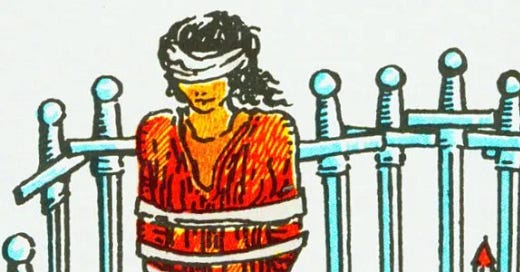


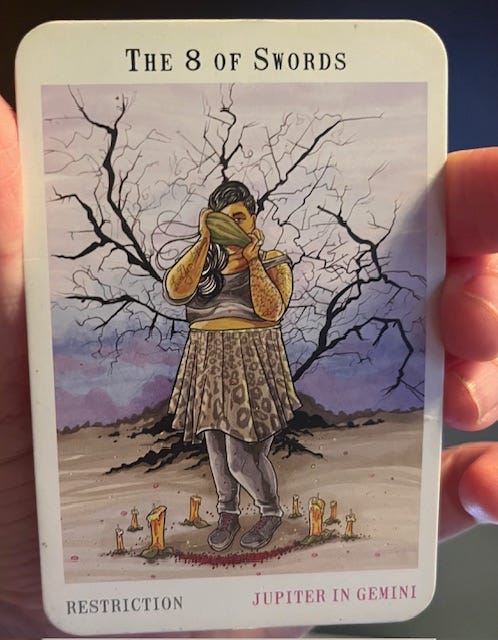
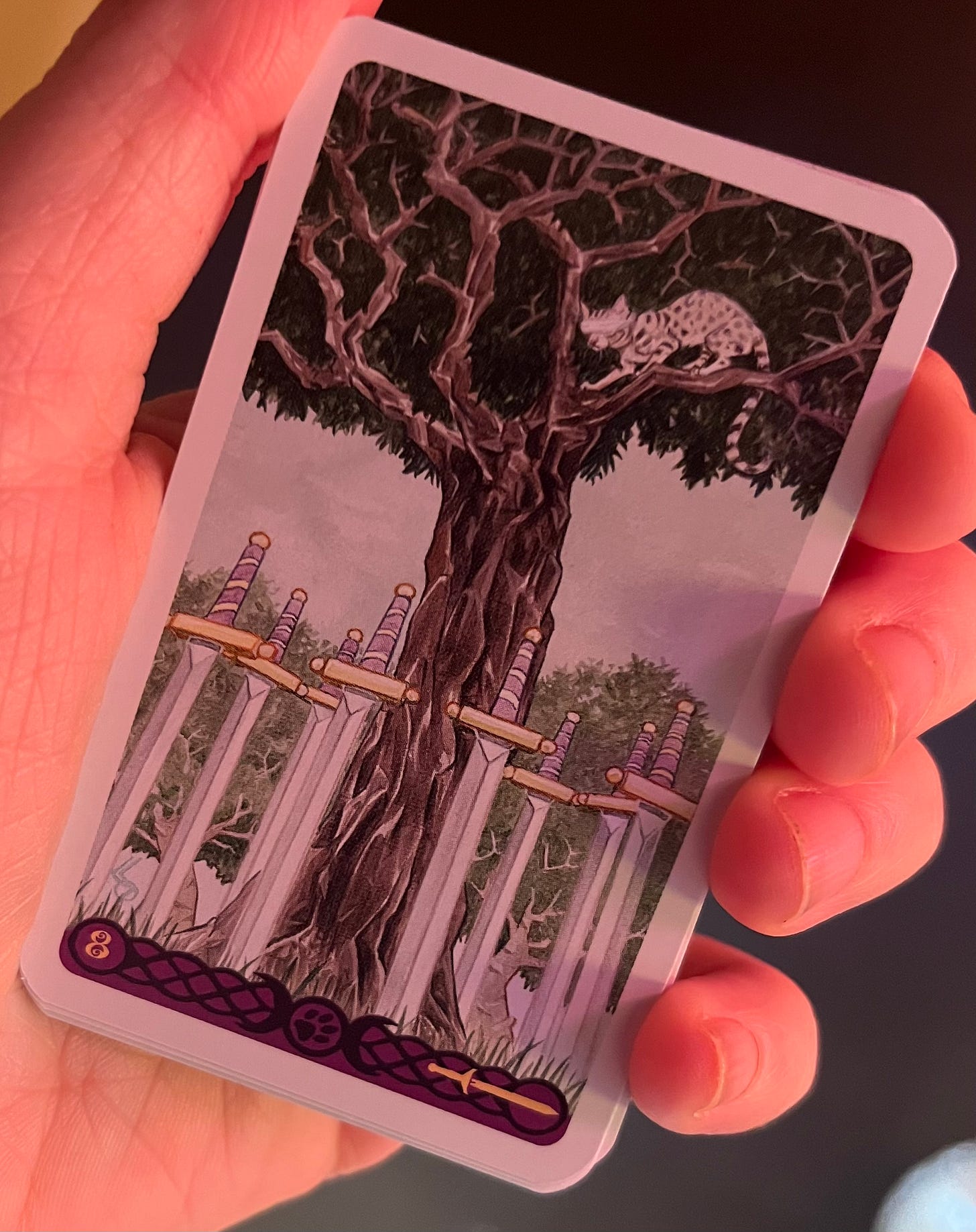
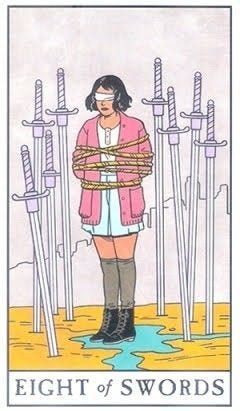
This has me thinking in so many new ways. Mostly about how if my body has so many constraints (mostly bedridden;ME+) then while reading this beautiful encouraging essay, my reaction was: I want no constraints on the page as a poet. To be bodily constrained but free poetically. I’m not sure yet what that would look like but it’s a thrilling thought! So thank you❣️
I also write from bed using my phone’s Notes app. I’m slow. I’ll write a line or stanza then my brain is done. My problem is I have many of these started poems but don’t always have the brainwidth to finish them. Something to ponder 🤔. How we have to be creative to figure out how to be creative 😂
Love this. Thank you, too, for the mention ❤️